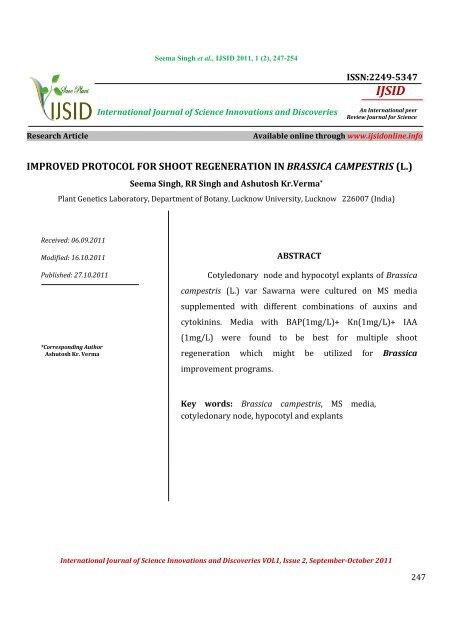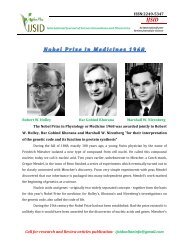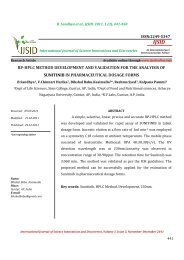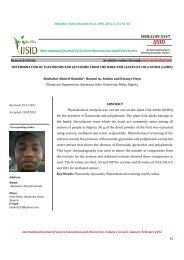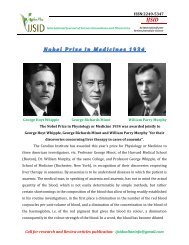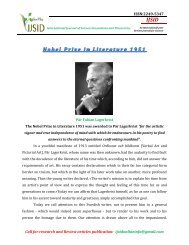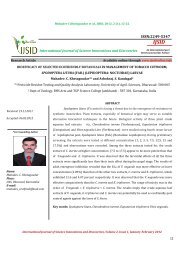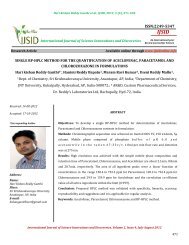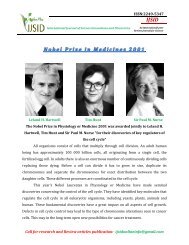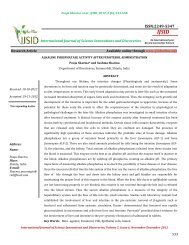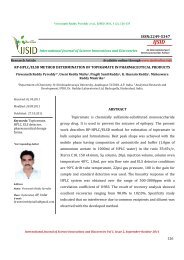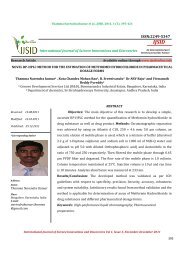improved protocol for shoot regeneration in ... - Ijsidonline.info
improved protocol for shoot regeneration in ... - Ijsidonline.info
improved protocol for shoot regeneration in ... - Ijsidonline.info
Create successful ePaper yourself
Turn your PDF publications into a flip-book with our unique Google optimized e-Paper software.
Seema S<strong>in</strong>gh et al., IJSID 2011, 1 (2), 247-254RESULTS AND DISCUSSIONThe multiple <strong>shoot</strong> <strong>for</strong>m cotyledonary node and hypocotyl explants were observed after 21 days<strong>in</strong> different comb<strong>in</strong>ations of hormone used. The percentage of responsive cotyledonary nodes andhypocotyls varied from 44 to85% and 28 to 61% respectively. A comb<strong>in</strong>ation of growth regulatorsconta<strong>in</strong><strong>in</strong>g BAP (1mg/L)+ Kn(1mg/L)+ IAA (1mg/L)(K) was found most suitable <strong>for</strong> multiple <strong>shoot</strong><strong>in</strong>duction <strong>in</strong> both explants. The maximum number of <strong>shoot</strong>s per explant from cotyledonary node was15.40± 0.70 (Fig. 5A) and from hypocotyl explant (Fig 5B) was 5.40± 1.08 (Table-1). Our results <strong>in</strong>dicatehighly significant (P
Seema S<strong>in</strong>gh et al., IJSID 2011, 1 (2), 247-254Table 1. Effect of different comb<strong>in</strong>ations of hormones on multiple <strong>shoot</strong> <strong>regeneration</strong> from cotyledonary and hypocotylexplants <strong>in</strong> Brassica comprastis (l.) var. sawarnaMedia (MS media+phytohormone)Cotyledonary node% ofresponsiveexplants Shoots/explant Shoot length% ofresponsiveexplantsHypocotylShoots/explantShootlengthBAP (0.5 mg/l)- a 55 1.90 ± 0.57 3.57 ± 0.41 36 1.30 ± 0.48 2.12 ± 0.68BAP (1.0 mg/l)- b 64 2.00 ± 0.82 3.29 ± 0.71 28 1.40 ± 0.52 2.25 ± 0.79BAP (1.5 mg/l)- c 48 2.60 ± 0.70 2.34 ± 0.61 40 1.90 ± 0.74 2.42 ± 0.75Kn (0.5 mg/l)- d44 1.40 ± 0.52 2.65 ± 0.59 38 0.90 ± 0.57 1.08 ± 0.33Kn (1.0 mg/l)- e 56 2.10 ± 0.57 1.73 ± 0.37 41 1.70 ± 0.48 1.00 ± 0.36Kn (1.5 mg/l)- f 51 1.30 ± 0.48 1.50 ± 0.31 58 1.20 ± 0.42 1.14 ± 0.30BAP+Kn (0.5 mg/l + 1.0 mg/l)- g72 3.10 ± 0.88 3.41 ± 0.63 55 1.80 ± 0.79 2.40 ± 0.64BAP+Kn (1.0 mg/l + 1.0 mg/l)- h 74 4.40 ± 0.84 2.31 ± 0.66 57 2.00 ± 0.67 2.81 ± 0.76BAP+Kn (1.0 mg/l + 0.5 mg/l)- i 58 3.00 ± 0.82 2.95 ± 0.76 61 1.80 ± 0.79 2.10 ± 0.67BAP+Kn+NAA (1.0 mg/l+1.0mg/l + 1.0 mg/l)- j 68 2.70 ± 0.48 3.58 ± 0.87 51 1.40 ± 0.52 3.26 ± 0.56BAP+Kn+IAA (1.0 mg/l + 1.0mg/l + 1.0 mg/l)- k 85 15.40 ± 0.70 4.46 ± 0.85 61 5.50 ± 1.08 2.35 ± 0.85BAP+Kn+IAA (2.0 mg/l + 1.0mg/l + 1.0 mg/l)- l 80 5.80 ± 0.79 3.08 ± 0.52 56 3.90 ± 0.88 2.06 ± 0.54BAP+Kn+IAA (3.0 mg/l + 1.0mg/l + 1.0 mg/l)-m 74 5.40 ± 0.70 2.22 ± 0.43 48 5.40 ± 1.07 2.01 ± 0.68BAP+Kn+IAA (1.0 mg/l + 1.0mg/l + 2.0 mg/l)- n 63 3.90 ± 0.88 5.58 ± 0.89 49 3.10 ± 0.74 3.39 ± 0.77BAP+Kn+IAA (1.0 mg/l + 1.0mg/l + 3.0 mg/l)- o 73 3.30 ± 0.82 5.22 ± 0.84 43 1.60 ± 0.70 4.65 ± 0.73BAP+Kn+IAA (1.0 mg/l + 2.0mg/l + 1.0 mg/l)- p 69 5.30 ± 0.67 2.94 ± 0.59 50 3.00 ± 0.82 2.51 ± 0.60BAP+Kn+IAA (1.0 mg/l + 3.0mg/l + 1.0 mg/l)- q 81 2.70 ± 0.48 2.83 ± 0.55 49 2.70 ± 1.06 2.27 ± 0.58ANOVA F (DF=16,153) - 215.45 ** 29.44 ** - 34.11 ** 19.17 ****- p0.05**- p
Seema S<strong>in</strong>gh et al., IJSID 2011, 1 (2), 247-254Fig. 1. Surface plot show<strong>in</strong>g relative association of <strong>shoot</strong> length with % of responsive explants and <strong>shoot</strong>s/explant<strong>in</strong> cotyledonary node.Fig. 2. Surface plot show<strong>in</strong>g relative association of <strong>shoot</strong> length with % of responsive explants and <strong>shoot</strong>s/explant<strong>in</strong> hypocotyl.International Journal of Science Innovations and Discoveries VOL1, Issue 2, September-October 2011251
Seema S<strong>in</strong>gh et al., IJSID 2011, 1 (2), 247-254Fig.3. Cluster analysis show<strong>in</strong>g tree diagram <strong>for</strong> 17 treatments on the basis of % of responsive explants, mean<strong>shoot</strong>s/explant and mean <strong>shoot</strong> length of Cotyledonary node.Fig.4. Cluster analysis show<strong>in</strong>g tree diagram <strong>for</strong> 17 treatments on the basis of % of responsive explants, mean<strong>shoot</strong>s/explant and mean <strong>shoot</strong> length of Hypocotyl.International Journal of Science Innovations and Discoveries VOL1, Issue 2, September-October 2011252
Seema S<strong>in</strong>gh et al., IJSID 2011, 1 (2), 247-254Fig.5. Multiple <strong>shoot</strong> <strong>in</strong>itiation <strong>in</strong> Brassica campestris (L.): (A) Multiple <strong>shoot</strong>s from cotyledonary node explant;(B) Multiple <strong>shoot</strong>s from hypocotyls explant; (C) Root<strong>in</strong>g <strong>in</strong> <strong>in</strong>-vitro regenerated <strong>shoot</strong>.A highly significant and positive correlation (P
Seema S<strong>in</strong>gh et al., IJSID 2011, 1 (2), 247-254and full strength media, supplemented with IBA (0.1mg/L) and NAA (1.0 mg/L), produced roots andconsequently the plantlets could be developed.CONCLUSIONIt is apparent from these results that MS media supplemented with BAP(1mg/L)+ Kn(1mg/L)+IAA(1mg/L) is more efficient <strong>for</strong> multiple <strong>shoot</strong> <strong>regeneration</strong> and it may be utilized <strong>in</strong> <strong>in</strong>-vitroimprovement program of Brassica campestris(L.) var. sawarna because <strong>in</strong> Brassica species organogenesisresponse are species and genotype specific 13 .REFERENCES1. Ali H, Ali Z, Ali HA, Mehmood S, Ali W (2007). In-vitro <strong>regeneration</strong> of Brassica napus L., cultivars (Star, Cyclone andWestar) from hypocotyls and cotyledonary leaves. Pakistan Journal of Botany 39(4), 1251-1256.2. Glemelius K., 1984. High growth rate and <strong>regeneration</strong> capacity of hypocotyl protoplast <strong>in</strong> some Brassicaceae, PhysiologyPlant 61:38-44.3. Lazzeri, P.A., Dunwell J.M., 1984 a. In-vitro <strong>shoot</strong> <strong>regeneration</strong> from seedl<strong>in</strong>g roots segments of Brassica oleracea var.Italica .Annuls. Botany 54, 351-361.4. Lazzeri, P.A., Dunwell J.M., 1984 b. Establishment of isolated root culture of Brassica species and <strong>regeneration</strong> fromcultivated roots segments of Brassica oleracea var Italica Annuls Botany 54, 351-361.5. George, L., Rao, P.S., 1980. In-vitro <strong>regeneration</strong> of mustard plant (Brassica juncea var.RAI-5) on cotyledon explants fromnon-irradiated, irradiated and mutagen treated seeds. Annuls Botany46,107-112.6. Chi GL, Pua E C, 1991. Role of ethylene on de-nova <strong>shoot</strong> <strong>regeneration</strong> from cotyledonary explants of Brassica campestrisspp. pekensis (Lour) oisson <strong>in</strong> –vitro. Plant Physiology 96,178-183.7. Dunwell, J.M., 1981. In-vitro <strong>regeneration</strong> from excised leaf disc of Brassica species. Journal of Experimental Botany32,789-799.8. Burbulis N, Bl<strong>in</strong>strubiene A, Kupriene R, Jonytiene V, Rugienius R, Staniene G, (2009). In- vitro <strong>regeneration</strong> of Brassicanapus L. <strong>shoot</strong>s from hypocotyls and stem segments. Zemdirbyste- Agriculture 3, 176-1859. Murashige, T., Skoog. F., 1962. A revised medium <strong>for</strong> rapid growth and bioassay with Tobacco tissue cultures. PlantPhysiology 15, 473-497.10. Stewart, C.N., Adang, M.J., Ali, J.A., Wetal. 1996. Insect control and dosage effect <strong>in</strong> transgenic canola conta<strong>in</strong><strong>in</strong>g a syntheticBacillus thur<strong>in</strong>genensis cry IAC gene. Plant Physiology 112, 115-120.11. Kamal, G.B., Asadollah, A., 2007. Effect of genotype explant type and nutrient medium components on canola (Brassicanapus L.) <strong>shoot</strong> <strong>in</strong> –vitro organogenesis. African Journal of Biotechnology.67, 861-897.12. Koh, W.L., Loh, C.S., 2000. Direct somatic embryogenesis, plant <strong>regeneration</strong> and <strong>in</strong> vitro flower<strong>in</strong>g <strong>in</strong> rapid cycl<strong>in</strong>g Brassicanapus. Plant Cell Report 19, 1177-1183.13. Dietert, M.F., Barron, S.A., Ocvodar, 1982. Effect of genotype on <strong>in</strong>-vitro culture <strong>in</strong> genus Brassica. Plant Science Letters26,233-240.International Journal of Science Innovations and Discoveries VOL1, Issue 2, September-October 2011254


